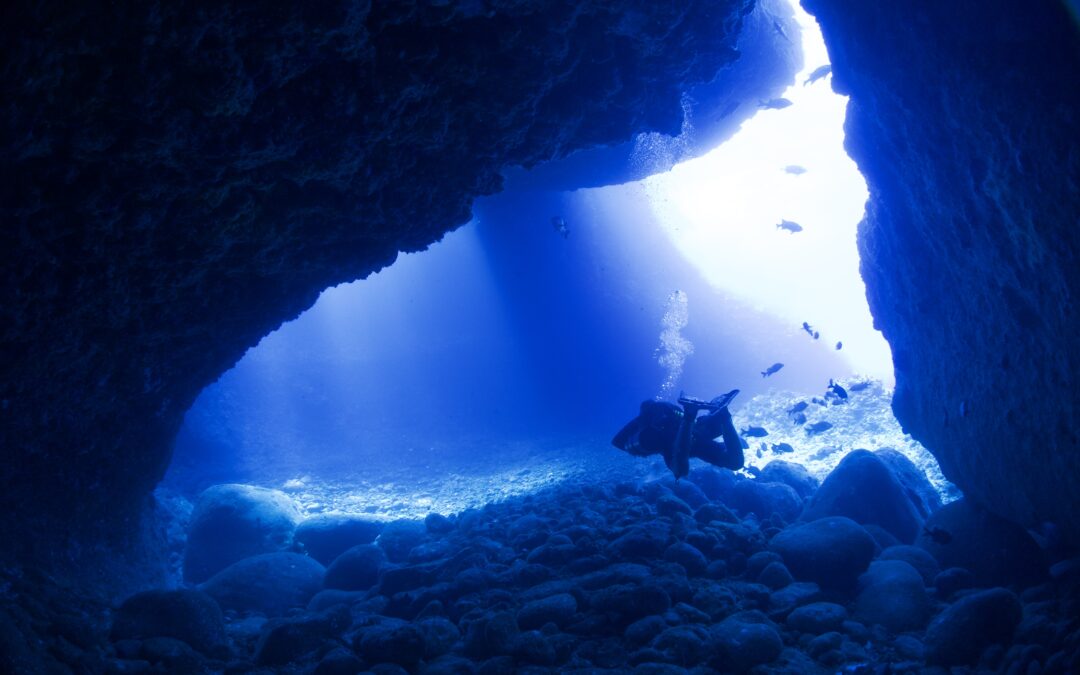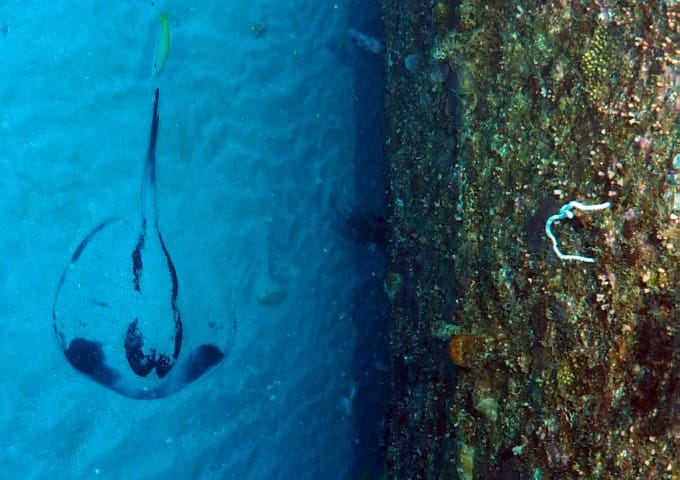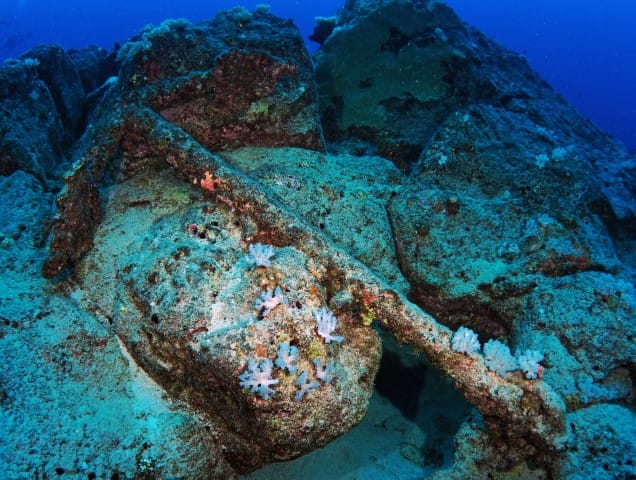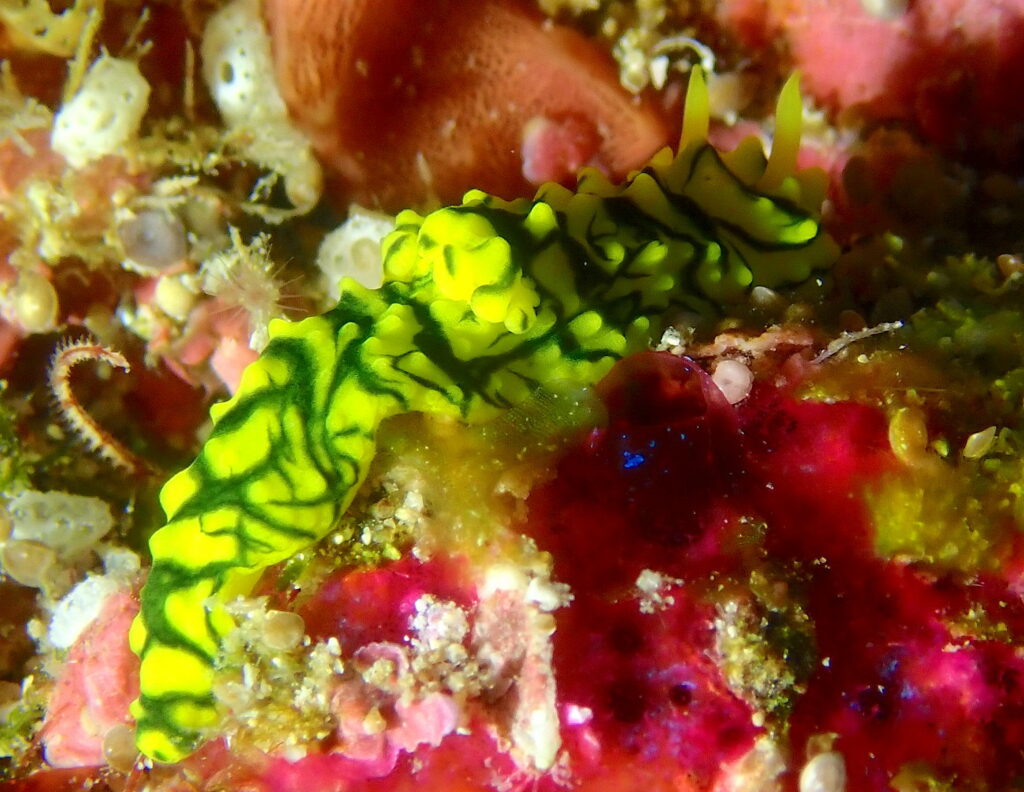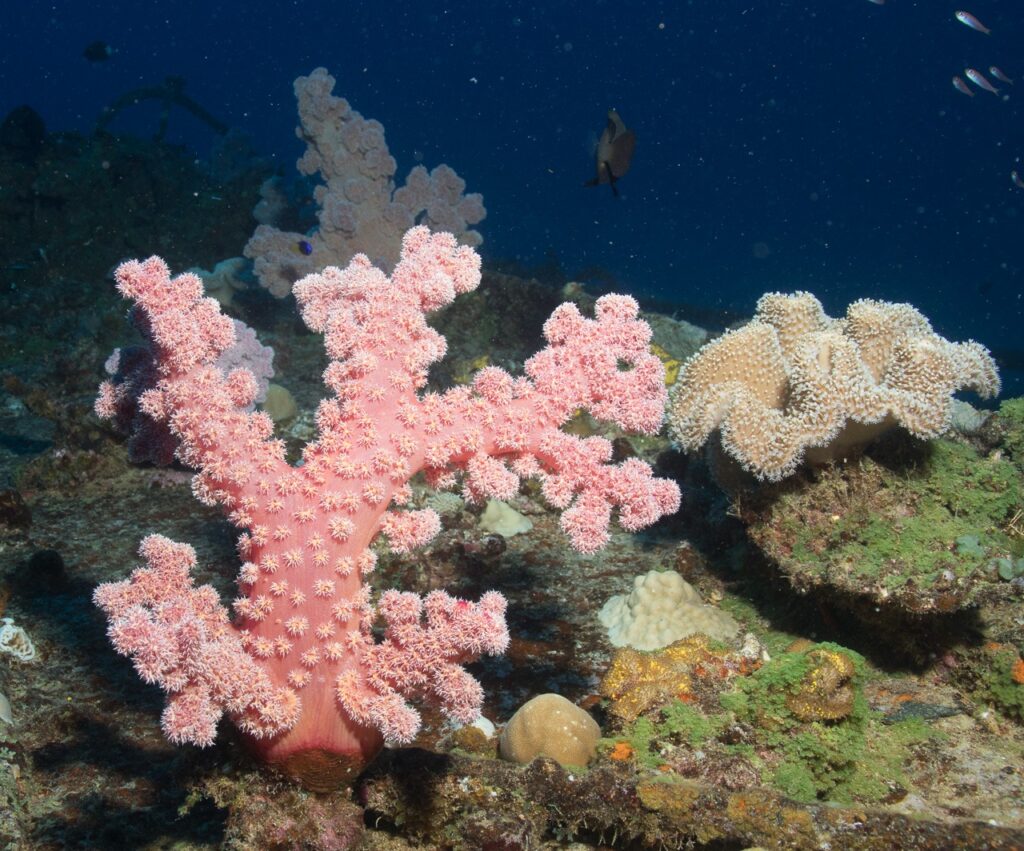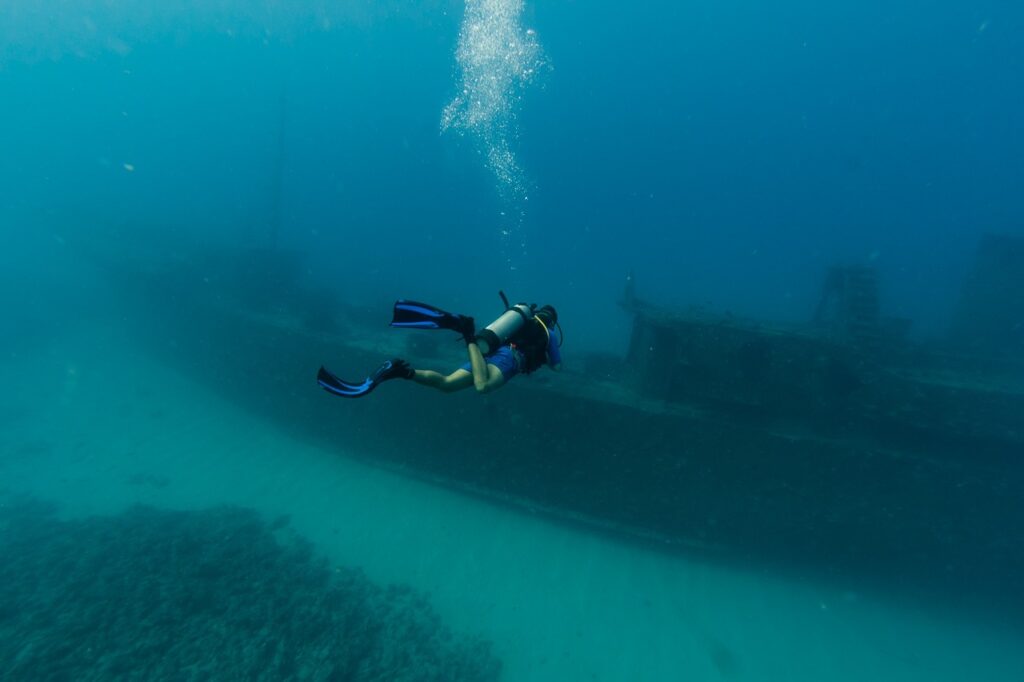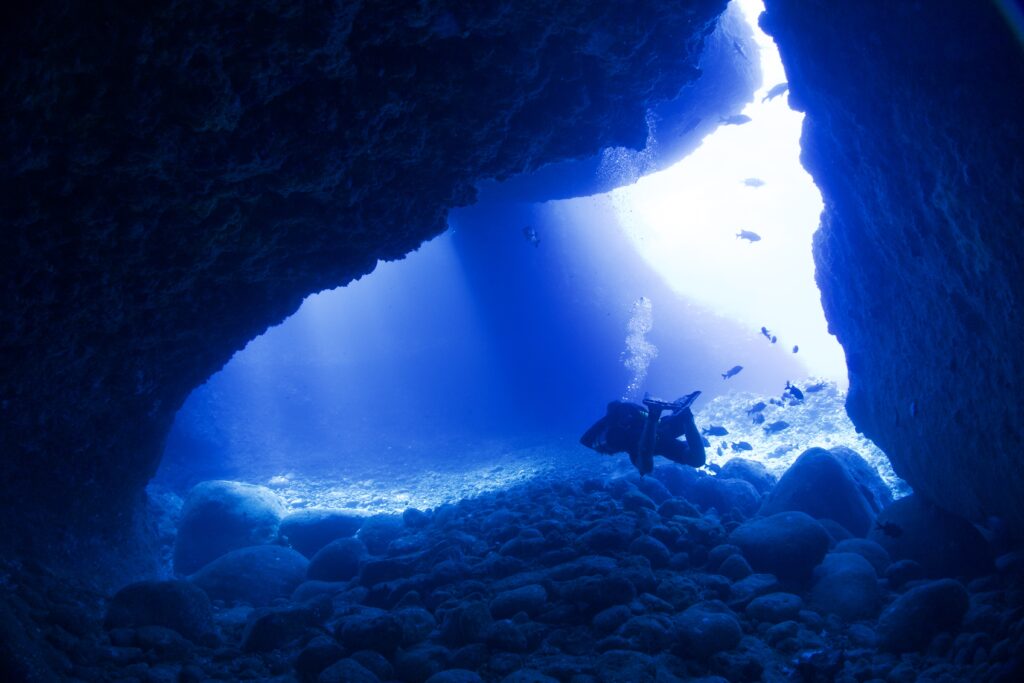We have a pretty wide variety of dive environments to choose from in the North of Mauritius. From impressive wrecks to colourful reefs, walls to drift and deep dives.
So let’s shine a spotlight on some of the more adventurous dive sites that you might visit as an Advanced Diver, or during your PADI Advanced Open Water Course.
1. Djabeda Wreck
Located lying almost due North around 200m off the island of Coin De Mire, Djabeda is a large Japanese fishing boat. She was sunk on purpose about 25 years ago to create an artificial reef. Surrounded by white sand, Djabeda is the “anchor” for all the marine life in this area and covered in beautiful soft coral. There are resident scorpion fish, octopus, lionfish and moray eels. You can spot big rays in the sand around Djabeda. The vessel is approximately 44m long, 10m high and 5m wide. Standing upright on its hull at a maximum depth of 34m makes the Djabeda the perfect site for PADI Deep Diver Specialty training. Exploring the wreck from the mast down, you can reach a comfortable maximum depth of around 28m, which is ideal for the PADI Deep Adventure Dive. Every diver wishes they could spend longer exploring Djabeda, so consider taking your advanced training to the next level by becoming a PADI Enriched Air (Nitrox) Diver. Breathing more oxygen and less nitrogen at depth means longer dives and shorter surface intervals.
2. Lost Anchor
This dive site is home to the gigantic ‘lost’ anchor from Djabeda! The topography is made up of giant boulders surrounded by huge sea fans and gorgonians. The structure of the reef encourages divers to explore and discover a rich diversity of marine life. You can spot schools of tropical fish, moray eels, scorpion, lionfish and leaf fish. If you have patience and a good eye, there are several tiny seahorses to find on the sea fans. The average depth of the site is around 22-25m, making it the perfect choice for a deeper dive, with enough deco time to explore.
3. The Wall
Keep an eye out here in the blue for some of the bigger pelagics! The Wall at Coin De Mire Island is also teeming with octopus and lobster, as well as many nudibranchs and shrimp for the macro lovers! Grab a torch and spend hours searching for the fun, cool, small stuff in the endless obscure nooks and crannies. With depths ranging from 12-40 metres, this dive site can be enjoyed by divers of all levels. The usually calm conditions and excellent visibility make the topography even more impressive. Depending on the tides, you can dive the wall from East to West, or from West to East in to Confetti Bay at Coin De Mire Island.
4. Carpenters
At the Easterly corner of Coin De Mire, Carpenters offers unusual and spectacular topography, making this dive a firm favourite. With sweeping walls, caverns and swim throughs penetrated by tropical sunlight, the cross-currents attract a wide array of life, including beautiful schools and barracuda. While the maximum depth is only about 18m, the current and topography makes Carpenters a more challenging dive for the more advanced/experienced diver. When the tides and the currents are right, be sure to dive here for a once-in-a-lifetime experience!
5. Chez Manta
Chez Manta means ‘House of the Rays’. But it’s not only rays you can find on this huge, deep reef – keep an eye out for some magnificent turtles! It’s impossible to explore all of Chez Manta in one dive. The depth varies between 15 and 28m. The topography of the shallow part consists more of huge boulders, whilst the deeper part comprises reef patches. Beside rays and turtles, you can find schools of red snapper, huge moray eels and big anemones with even bigger clownfish. Don’t forget to take a closer look under the boulders to find all sorts of shrimps, crabs and octopus.
6. Stella Maru
Just like Djabeda, the Stella Maru is a former Japanese fishing boat, purposefully sunk in 1987 to create an artificial reef. Situated off the coast of Trou-aux-Biches, the trawler rests on a sandy bottom and is home to a school of blue triggerfish. Two friendly Japanese morays, stonefish, scorpion fish, octopus, nudibranchs, shells and a rich marine fauna have also found refuge amongst the wreck. On the mast you can find a resident blind pufferfish. As the reef is super close to the wreck, this dive site is perfect to combine with a reef dive. Sitting at 25m, this wreck is ideal for PADI Wreck Diver Specialty training.
7. Batfish Wall
With visibility of up to 50m, this impressive wall dive boasts an abundance of life and vibrant, untouched corals. Located at Snake Island out in the open Indian Ocean, this dive is better suited for the more experienced diver. Surface conditions and underwater currents can be a little more intense than in the protected bays nearer to shore. The site takes its name from the huge schools of friendly batfish who follow divers along their dive and play with their bubbles. With some as large as a small bath towel, they can swim across your mask, giving you an incredible close up. The wall also offers a lot of macro life – nudibranchs, shrimps and crabs.
8. Shark Cathedral
This is the go-to-dive-site for a high chance of passively observing reef sharks in their natural habitat. This dive site is one of the most impressive and beautiful places to explore underwater. The ‘cathedral’ is a giant basin reached through an overhead swim-through. As the sunlight drops in from the top and the sharks circle within the cathedral, everything else melts away. This dive site is also located at Round Island, so the current and swell can make this a challenging dive. The site is also known for its vivid, pristine and healthy corals, as well as sightings of other pelagics such as king fish, yellow fin tuna and giant trevally.
Bonus: Ti Corail
Sitting at 15m, Ti Corail might not be deep, but it’s certainly an all-time favourite for all divers. Consisting of three coral strips surrounded by sand, being able to expertly hover a few metres above the reef, you will see Ti Corail at its best, and full of life! It’s the perfect photography and/or macro lover’s dive site: nudibranchs, shrimp, octopus, ribbon and moray eels, leaf scorpion fish and so much more. Dive the site with patience and a good eye to appreciate how much it’s bursting with life! No matter how often you dive this site, it never gets boring, and especially at night!!
Consider becoming a PADI Advanced Open Water Diver with us in Mauritius, and enjoy exploring some of these special dive sites! For the Certified Advanced Divers out there, which dive site would you put on your bucket list?

